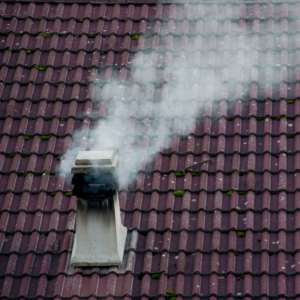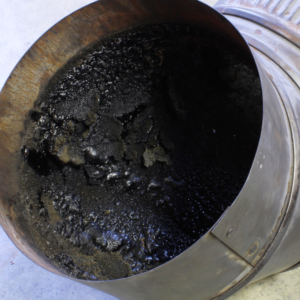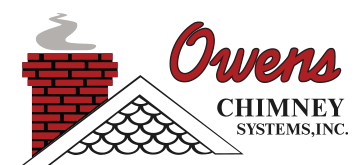A dirty chimney increases the risk of chimney fires. Each year over 20,000 chimney fires ignite and burn within chimneys across America, and the dirtier your chimney is, the more at risk you are of experiencing one yourself. That is because something called creosote builds up along the walls of the chimney.
You do not want to let the chimney fire burn itself out. You want to get the fire department to your home as soon as possible.
Creosote is a byproduct of the fires made in your fireplace. As the wood burns small particles of unburnt wood are released with the smoke. As the smoke rises up the chimney, it cools and condenses on the side of the system. This deposit of black material is extremely combustible and can be ignited without your knowledge.
What Do I Do During a Chimney Fire?
Chimney fires caused by creosote are very dangerous. They can quickly spread from the chimney to other parts of your home, becoming a real threat to your family and property.
If you notice a fire in your chimney, get yourself and your family out of the home immediately and call 911.
You do not want to let the chimney fire burn itself out. You want to get the fire department to your home as soon as possible. The fact is, a chimney fire can burn at temperatures up to 2100 degrees F. This means that the brick and mortar in your chimney and the clay tiles that line the flue can crack and crumble under the heat.
If you notice a fire in your chimney, get yourself and your family out of the home immediately and call 911.
How Do I Prevent Chimney Fires?
 It is possible to lower the rate at which creosote is formed in your chimney. The type of fuel that you use in your fireplace is the big factor in how efficient your fire will burn. An efficient fire means more of the fuel is burnt and less of it is collected on the chimney walls. Therefore, using properly seasoned and dried wood lowers the rate at which creosote collects.
It is possible to lower the rate at which creosote is formed in your chimney. The type of fuel that you use in your fireplace is the big factor in how efficient your fire will burn. An efficient fire means more of the fuel is burnt and less of it is collected on the chimney walls. Therefore, using properly seasoned and dried wood lowers the rate at which creosote collects.
No matter how efficient your fires burn, though, over time, creosote will slowly build up on the walls of your chimney. Preventing a chimney fire typically comes down to having your chimney routinely serviced. The buildup of soot and creosote are the main culprits of chimney fires. Regular sweeping and inspections will keep your chimney healthy and reduce your chances of a chimney fire.
How Do I Know if There’s a Fire in My Chimney?
Many people have been able to spot a chimney fire because they heard it first. Sometimes a chimney fire will cause loud cracking and popping noises – and sometimes it will even hiss. There have been reports of chimney fire being as loud as a passing train. Most of the time, however, when someone hears a chimney fire, it is slightly louder than the fire in their fireplace.
Another way you might spot a chimney fire is by noticing thicker-than-normal smoke. A typical fire in a fireplace will create a small amount of smoke that easily rises up the chimney to the outside of the house. During a chimney fire, however, it is possible to experience thick and sometimes dark smoke that doesn’t float up as easily.
One way people have reported spotting a chimney fire is by smell. When the chimney fire burns it often burns at extremely hot temperatures. Heated brick and mortar and clay tiles will actually give off a specific burning smell. If it smells like something is burning, well… something is probably burning.
Again, if you experience any of the signs of a chimney fire, get out of the house and get the fire department to your property as quickly as possible. They can confirm whether there is a chimney fire or not, then put an end to the fire before it gets out of hand. Whatever you do, do not try to put it out yourself!
Whatever you do, do not try to put it out yourself!
Unfortunately, not all chimney fires are as dramatic. Oftentimes, chimney fires occur unnoticed or undetected because they are slow-burning, not getting near enough air to be dramatic or noticed. But, trust us – these can cause the some major damage, just the same.
How Do I Know if I’ve Had a Chimney Fire in the Past?
If a chimney has had a fire once, its risk of having another fire is increased. If this occurs, the creosote that’s already present will get puffy and expand, reducing the exhaust out of the chimney, and raising the internal temperature of it, as well. All of these things increase the likelihood that yet another fire could occur.
There are many things that can point to a chimney having had a fire within it. Noticing these signs of a former chimney fire can help you to take action to prevent another one – as well as clogs and other hazards – from occurring. If you notice any of these things, call Owens Chimney Systems and schedule a cleaning, inspection, and any necessary repair work right away:
 Cracked clay tiles in the flue
Cracked clay tiles in the flue- Damage to your roof
- Damage to things on the roof such as antennas, satellite dishes, or roof vents
- Distorted, melted, or discolored chimney cap
- Cracked brick and mortar
- Puffy and expanded creosote
- Creosote buildup on the roof
All of these things can indicate that an extremely hot chimney fire has occurred and that another is prepped and ready to ignite.
Don’t Hesitate – Call Owens Chimney Systems
The team of highly skilled, professionally trained, and deeply knowledgeable technicians at Owens Chimney systems will help you prevent chimney fires and repair damage to your fireplace and chimney. We are certified by the Chimney Safety Institute of America (CSIA) meaning we can help keep your chimney and fireplace maintained and healthy.
Make sure you’re able to enjoy all the things a beautiful fireplace has to offer. Call us at 704-486-1146 or reach out online today.
